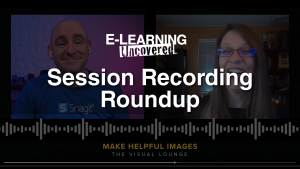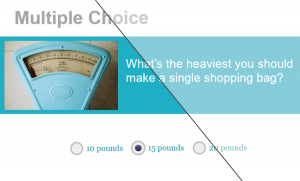Converting Classroom Training to E-Learning: Key Questions
Recently I’ve worked on several projects for clients where I converted their existing classroom training to e-learning. I usually had three types of material to work with: a PowerPoint presentation for the course, instructor and participant guides, and an audio or video recording of an instructor-led (classroom or webinar) version of the course.
What comes next? As I begin a new project like this I like to ask myself these key questions to help clarify the task of converting the course to e-learning.
1. Is the content well-organized and does it flow well?
In many cases it’s the instructor, not the PowerPoint presentation or participant guide, who really provides coherence to the material. By itself, a PowerPoint presentation or course guide may need major rework to create a logical flow to the content. If that’s the case, I like to develop an updated course outline and go over it with my client.
2. Are there graphics that are useful, relevant, clear, and attractive?
E-learning courses need to be visually vibrant and appealing to command and retain the attention of the learner. In the classroom, an engaging instructor can make up for a boring or ugly PowerPoint. In self-paced e-learning, the visuals need to stand on their own. Sometimes we have great instructional graphics to work with. Other times, the graphics were just an afterthought. And in some cases, they are non-existent! Am I dealing with just a few boring pictures or incomprehensible diagrams? How much will I need to create–or re-create? Do I have permission to use all of the images in the PowerPoint?
3. How does the instructor presentation compare to the slides or guide?
This can be a huge issue if what the instructor talks about differs significantly from what’s on the slides or in the guide. Instructors and course writers may have their own ideas about what learners need to know. Often this is the classic “corporate office” vs. “real world” conflict. If the instructor skips over a section, is that because it isn’t relevant, because the instructor disagrees, or because he or she is running short on time? If he spends a lot more time on a given subject, is it because it is really that important, because a student question took the course on a tangent, or because the instructor just happens to be passionate about that particular topic? I will need to talk to my client and their subject-matter experts to discern what the most important content is as it relates to what the learner will need to do on the job.
4. If there is no instructor presentation, how do I fill in the gaps?
Most instructor-led materials only contain about 30 to 50% of what is actually conveyed to the students in the classroom—the instructor provides the rest in the form of examples, elaborations, etc. So if all you have is the materials, how do you get that missing 50 to 70%? Can you interview an instructor or subject-matter expert? Do any of the instructors keep their own personal notes? Are there other materials I can look at?
5. Are there assessments in the course, and if so are they good ones?
It’s common for a client to want a “final exam” that students take at the end of the e-learning course and knowledge-check questions along the way. Rarely are these found in the instructor-led materials. That’s typically because questions in the classroom are done “on the fly” by the instructor during the course. What kinds of assessments will I need to create to check student knowledge during the course, and allow them to apply what they have learned?
6. Does the content accomplish the goal of the course?
Or to put it another way, is the content clearly tied back to the job? Will it change behavior in a way consistent with what the client wants? We can’t sit back and assume that the existing instructor-led course accomplishes these goals. Making the transition to e-learning can be a good way to help a client “upgrade” the content in the course and make it more relevant to the work goals the client has for their employees.
Those are the questions on my mind as I prepare to convert a “traditional” training course to e-learning. What’s on your mind?

 Previous Post
Previous Post




Great article. Along with number 6, I l examine the existing content to determine the “nice to know” vs. the “need to know to meet the objectives.” This usually allows me to cut the length of the course because sitting at a computer for an hour is much different than sitting in a classroom for an hour.
Great comment Betsy – thanks! Your strategy is another smart way to “upgrade” the course as you help your client make the transition to e-learning.
Rod , you have compiled the thoughts on e-learning comprehensively. But only one aspect bothers me. My experience tells me that students find e-learning slightly monotonous because of lack of interactivity. If it is possible to incorporate live online classes in virtual classrooms ( http://www.wiziq.com/Virtual_Classroom.aspx ) so that the learners can solve their issues then it might work better. What are your thoughts?
Hi Kajal. I like the idea of virtual classrooms a lot, as long as they meet the needs of the client. Sometimes a client requires e-learning because individual employees’ schedules cannot accommodate a live virtual classroom schedule. Instead, e-learning is necessary because it’s available on-demand at a time of the learner’s choosing. However, if a virtual classroom is a good fit for a client’s requirements, I’m definitely a proponent. Thanks for your insights!
Its amazing post of converting classroom training to e-learning. I blog often and I truly appreciate your
content. The article has truly peaked my interest. I’m going to take a note of your website and keep checking for new details about once a week. in IB World Academy